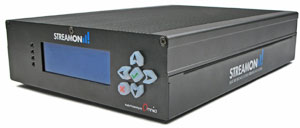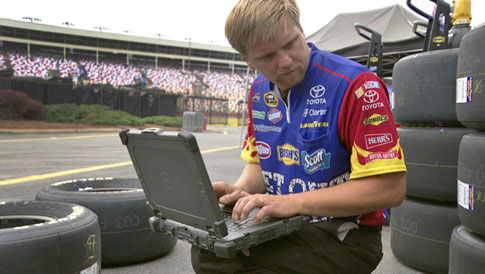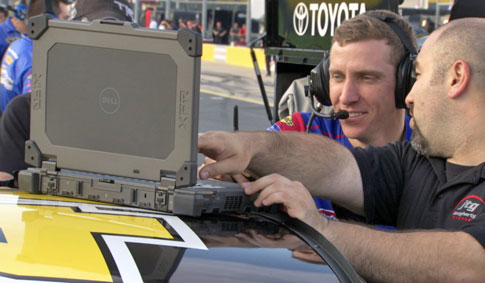« May 2013 | Main | August 2013 »
June 25, 2013
Logic Supply's logical approach to engineering their own systems
When it comes to rugged computing gear, most people interested in this industry know the big players that dominate the market and get all the media coverage. But that's not everything there is. Unbeknownst to many outside of the circle of customers and prospects, a surprising number of smaller companies are designing and manufacturing rugged computing systems of one type or another. At times we come across them by chance. Other times they find us.
And so it was with Logic Supply, located in South Burlington, a small town in the northwestern part of Vermont. They call themselves "a leading provider of specialized rugged systems for industrial applications," and asked if we could include them in our resource page for rugged system vendors. We could. And that led to some back and forth where I learned that while Logic Supply distributes a variety of rugged/embedded systems and components, they have also begun developing their own high-end chassis under their own LGX brand. That was interesting, and so we arranged an interview with Rodney Hill, Logic Supply's lead engineer, on the company, and how they go about creating their own, home-developed solutions in addition to being a distributor of products engineered elsewhere.
RuggedPCReview: If you had to describe Logic Supply’s approach to case and system engineering in a minute or less, what would you say?
Rodney Hill (Logic Supply): So, LGX is Logic Supply’s engineering arm. The design approach for LGX systems and cases can be boiled down to three ideas. First is our “designed to be redesigned†philosophy. Seed designs that are scalable and modular. From a seed idea we can create a product line through swappable front- and back-plates or resized geometry. Second is mass customization — by using standardized screws, paints, sheet metal folds, and design concepts, we leverage mass produced hardware whenever possible to keep the cost low. And through our modular designs we customize the off-the-shelf by using “upgrade kits,†which are quick to source and are cost-effective. Finally, innovation, not invention! There is a difference. Add value to things that work well, but do not re-invent the wheel.
Was that under a minute?
RuggedPCReview: Almost. But now let’s expand. You said scalable, modular, and “designed to be redesigned.†What do you mean by this?
Rodney Hill (Logic Supply): Designing a new chassis is four to five times the price of redesigning a seed design. Much of the time wasted in projects is done so while selecting paints, screws, boxing, foam, metal fold designs, etc. By using standardized design methods and seed concepts, our team can immediately start adding value. Ultimately the customer is only paying for the design and not the time the engineers spent trying to get their act together. We will be faster and more focused on quality and containing costs and risk.
So, to your question, designed to be redesigned systems from LGX have already incorporated flexible features to accommodate 80% of the customizations that customers request with off-the-shelf hardware. The last 20% are resolved with ‘upgrade’ kits that will be included with the off-the-shelf chassis kit. But you’re also using the proven benefits of the rest of the chassis (EMI and RFI shielding, for instance), and only adding risk in small portions. Meaning the rest of the chassis is still meeting all the same design criteria it was originally intended to support. So you can easily customize it without the risk of any negative effects on any of those features.
In terms of scalability versus modularity — there are design themes seen in our cases. If you look carefully enough, you can begin to see connections between designs. The NC200 and the MK150 are two totally different designs – however they share about 80% of the same DNA, from vent holes to metal folds, etc.

RuggedPCReview: How does cooling play into ruggedization?
Rodney Hill (Logic Supply): Nature always wins. Meaning dust and water will destroy everything if given the chance. You need to decide how long the computer needs to live, and how much you’re willing to pay for it. Heat will shorten the life of components.
So in terms of chassis design concepts: Keep the chassis cool as possible and as quiet as possible. Intelligent design is required to incorporate standardized cooling methods and proven airflow paths to cool many types of devices. Fan diameter, placing, vent design all will have effects on the acoustic design as well. Logic Supply will engineer noise out of systems with fan-muffling technologies, maximizing air throughput with smaller, more simple fans by identifying inefficiencies in orifice design. In short, having a fan against a grille will kill 50-60% of the airflow and multiply the noise by two or three times.
Vent holes equal dust. Dust causes fans to break, which in turn results in hot computers. Eliminate vents and go fanless. The operational temperatures and ruggedness greatly increase. Logic Supply defines “fanless†different than the IMP mass market. Our definition is not simply “no fans.†It is more than that: no fans, no vents for dust and dirt, and maintain the ability to cool the computer system at 100% duty load for hours and days at a time. We want these systems to be heavy duty, and also to be able to last a long time. It is rated for high performance!
RuggedPCReview: Can you talk about the design process? How long does it take from start to finish?
Rodney Hill (Logic Supply): It happens pretty fast. This year we’ve done a fanless Mini-ITX case, a 1U rackmount case, a NUC [Next Unit of Computing] case, and we’re finalizing a fanless NUC case right now. We’ve also finished a number of customer-specific designs. These design concepts typically originate in sales — you know, this customer wants to do X and none of our existing solutions do it. But because we use seed designs, we don’t start from scratch. It really all depends, but usually designs take under three weeks, and prototypes are ready a few weeks after that. We review, test, and modify, then we’re typically getting production units in-house around five or six weeks after that.
These core platforms can then be sold off-the-shelf, or customers can either go the semi-custom route or more radically modify the design. For simple modifications (like back-plates, front-plates, and simple changes) maybe one to five days in design and a three to four day lead on parts. For customized chassis design with samples, five to six weeks, and four to six after that to mass production.
RuggedPCReview: Alright, finally, can you give us an example of a successful customer product development?
Rodney Hill (Logic Supply): Sure. Last year we worked with a company called StreamOn to make a custom appliance with off-the-shelf components. StreamOn offers streaming audio solutions for the radio broadcast industry. The hardware they were using at the time was going End-of-Life, and they also needed a more specialized embedded system because their business was growing and they wanted to offer more features to their customers.  They needed a variety of other things — outsourced fulfillment and things like that — but from an engineering perspective it was mostly that — the EOL and specialization. And all while remaining affordable for their customers. We worked from an existing system design — the ML250 — and customized it toward what they needed. We added an SSD, LCD screen and multifunction buttons, and on-case branding.
They needed a variety of other things — outsourced fulfillment and things like that — but from an engineering perspective it was mostly that — the EOL and specialization. And all while remaining affordable for their customers. We worked from an existing system design — the ML250 — and customized it toward what they needed. We added an SSD, LCD screen and multifunction buttons, and on-case branding.
Ultimately, the system we created was something like 30% smaller, and it was fanless, so it was more efficient, and had a longer life expectancy. It also had a built-in watchdog timer and auto restart bios so it could avoid any complications related to sudden power outages, etc. And it actually ended up being even less expensive for their customers than what they were previously offering. So that all worked out quite well. In fact, they recently won the [Radio World] “Cool Stuff Award,†which was pretty, well, cool!
This whole process was consistent with our typical design timeline, by the way. From the initial conversations to mass production — with samples and prototyping — we took about three months.
Posted by conradb212 at 3:16 PM
June 24, 2013
Why the JTG Daugherty NASCAR racing team chose rugged Dells
The Christmas tree began its count-down. Yellow, yellow, yellow, GREEN! For an anxious moment, the racing slicks of my supercharged Acura fought for traction, then bit. 8,000, 8,500, 8,800 rpm, shift. Shift. Shift. Shift, and the 1/4-mile at Sacramento Raceway was over. The car slowed and I reached over to stop data logging on the laptop securely sitting on its mount, just having recorded tens of thousands of data points as the car shot down the track. The laptop was a Dell Latitude ATG 630D, connected via USB to the Hondata ECU under the dash of the car. Minutes later I would analyze the run on the Dell, temperatures, shift points, slippage, air/fuel ratio, knocks, timing, etc., and then make changes on the fly. The next heat was in less than 15 minutes.
At the time I didn't know that a few years later I'd be talking with the JTG Daugherty NASCAR racing team about how they used rugged Dell laptops on their #47 Sprint Cup car,  driven by NASCAR legend Bobby Labonte. Labonte won the Cup in 2000 during an era where he was a perennial contender. And also won IROC in 2001, following in the footsteps of his brother Terry Labonte, also an IROC and Cup champion. Now a senior amongst NASCAR drivers at age 49, Labonte's piloting car #47 for the team owned by Jodi and Tad Geschickter, and NBA Hall of Famer Brad Daugherty. Lady Luck hasn't been too kind to them this season, but that's certainly not due to this talented group and also not due to the technology they're using. Most recently, while Martin Truex Jr. won at Sonoma Raceway in his Toyota Camry, a blown oil cooler ended Labonte's race in essentially the same Camry before it even began. Those are the breaks.
driven by NASCAR legend Bobby Labonte. Labonte won the Cup in 2000 during an era where he was a perennial contender. And also won IROC in 2001, following in the footsteps of his brother Terry Labonte, also an IROC and Cup champion. Now a senior amongst NASCAR drivers at age 49, Labonte's piloting car #47 for the team owned by Jodi and Tad Geschickter, and NBA Hall of Famer Brad Daugherty. Lady Luck hasn't been too kind to them this season, but that's certainly not due to this talented group and also not due to the technology they're using. Most recently, while Martin Truex Jr. won at Sonoma Raceway in his Toyota Camry, a blown oil cooler ended Labonte's race in essentially the same Camry before it even began. Those are the breaks.
So I felt almost guilty when I got on the phone Monday morning after that race with Matt Corey, who is the IT administrator at JTG Daugherty Racing, and Dell's Umang Patel and Alan Auyeung to discuss JTG Daugherty's use of Dell technology. Corey in particular, probably didn't feel too good after the frustrating weekend and had plenty of other things to do at their shop, but he took the call. Much appreciated.
So how is JTG Daugherty Racing using Dell computers? And what made them decide to use Dell from the driver to the garage and the pit crew to the data center with a complete suite of Dell technology and solutions that also includes rugged Dell ATG and XFR laptops? The choice of Dell for data center and office isn't much of a surprise, given that Dell has consistently been in the top three PC vendors worldwide and in the US. What's more interesting is that JTG Daugherty also chose Dell for their rugged laptops, a field dominated by Panasonic, Getac and a number of other vendors specializing on rugged equipment.
Corey began by explaining the inherent need of a NASCAR racing team for rugged technology. No surprises here. There's rain, dust, vibration, extreme temperatures, the whole gamut of hazards rugged mobile computing gear is designed and built to survive. Add to that the extreme time crunch as a race car is tested and prepared, the extreme need for absolute reliability in a sport where fractions of a second matter, and a race car is checked, refueled and has all of its tires changed in something like 13 seconds. Things simply must not go wrong, ever, in such an environment, and racing teams certainly cannot put up with finicky computing technology that may or may not be up to the job. As an example, Corey tells of an incident where a consumer laptop simply wasn't able to handle vibration, causing them a lot of grief.

So as a result, JTG Daugherty now uses rugged gear. Their race engineering team has Dell Latitude E6430 ATG laptops. The ultra-rugged Dell Latitude X6420 XFR is used on the truck and trailer. They also use Windows-based Dell Latitude 10 tablets in Griffin Survivor cases supplied by Dell. All of this means that the team can collect performance stats, analyze it, and make changes quickly and reliably. "We have connectivity everywhere," said Corey. "As the car chief makes a decision about a change to the car, for example, he now notes this on his Latitude 10 and the information is instantly communicated to everyone across the organization. All decisions from the car chief trickle down to updates to the racecar and with everyone synced together with tablets and other Dell technology, that information flow is now much faster, more reliable and more efficient."

But still, why Dell for the rugged gear? Here I expected Corey to point to the advantage of dealing with a one-stop vendor. Instead he says that they had used Toughbooks in the past and liked them, but that "they really didn't change much over the years, same always," and that Dell updates more frequently. "We don't want "plain vanilla," he said, "we want to be on the cutting edge of technology" and lists the memory and processing speed required to power through race simulations, high resolution imaging, and massive data sets.
Staying at, or near, the leading edge in technology while still adhering to the longer purchase cycles and life spans of rugged equipment, and guard against obsolescence of docks, peripherals, accessories and software has always been a challenge for the rugged computing industry. While Intel tends to unveil a new processor generation and ancillary technology every 12 to 18 months, the rugged industry cannot possibly update at the same pace. Even Dell is not immune in that regard; as of now, the rugged XFR laptop is still based on the E6420 platform.
Yet, Dell does have the advantage of very high production volume and with that comes access to the very latest technology. Combine that with the convenience and peace of mind of dealing with a large one-stop shop, and it's no surprise that even a NASCAR racing team chose Dell.
See NASCAR Team Selects Dell to Speed Past the Competition, Dell's Latitude for Rugged Mobility page, and RuggedPCReview.com's most recent reviews of the Dell Latitude ATG and Dell Latitude XFR.
Posted by conradb212 at 7:47 PM
















